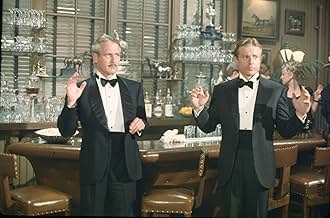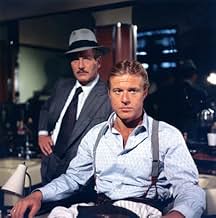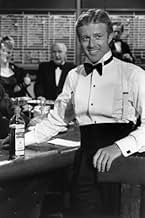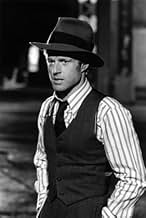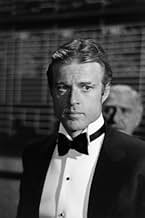सितंबर 1936 में शिकागो में, एक युवा ठग अपने हत्यारे साथी का बदला लेने के लिए एक आपराधिक बैंकर से भाग्य जीतने के लिए बड़े कॉन के एक मास्टर के साथ मिलकर काम करता है।सितंबर 1936 में शिकागो में, एक युवा ठग अपने हत्यारे साथी का बदला लेने के लिए एक आपराधिक बैंकर से भाग्य जीतने के लिए बड़े कॉन के एक मास्टर के साथ मिलकर काम करता है।सितंबर 1936 में शिकागो में, एक युवा ठग अपने हत्यारे साथी का बदला लेने के लिए एक आपराधिक बैंकर से भाग्य जीतने के लिए बड़े कॉन के एक मास्टर के साथ मिलकर काम करता है।
- 7 ऑस्कर जीते
- 18 जीत और कुल 6 नामांकन
Robert Earl Jones
- Luther Coleman
- (as Robertearl Jones)
James Sloyan
- Mottola
- (as James J. Sloyan)
सारांश
Reviewers say 'The Sting' is celebrated for its intricate plot, charismatic performances by Paul Newman and Robert Redford, and nostalgic charm of the 1930s setting. The film's clever con schemes, dynamic character interactions, and witty dialogue are frequently highlighted. The iconic ragtime music enhances the atmosphere, while meticulous production design immerses viewers. Despite some criticisms regarding historical inaccuracies and predictability, 'The Sting' is widely regarded as a timeless classic.
फ़ीचर्ड समीक्षाएं
At first sight, THE STING appears to be nothing more than a television movie. It is entirely plot-driven with no real stand out characters or personalities. What makes the film work is excellent production design and a delightfully clever plot filled with many surprises. The movie is feather-weight emotionally, but the depth of the "con" and the way it is fashioned by screenwriter David Ward leaves you with a pleasant experience.
This is more Redford's film than Newman's, who reunite with George Roy Hill, director of BUTCH CASSIDY AND THE SUNDANCE KID. The legendary actors were more flesh and blood in that film, but here, they are merely players who carry the story along. With lesser actors, THE STING may have been a forgettable piece of work. Redford does all of the dirty work after Newman's initial "hook", but the omniscient presence of Newman, as big-time grifter "Henry Gondorff" exists throughout. A mysterious gloved character, a crooked cop, the FBI, and a seemingly bigger con-man "Doyle Lonnegan" (played by the late, great Robert Shaw) are some of the players who are involved in some events that seem to be manipulated by an unseen force. Is Newman as good as he claims in trying to clean out Shaw? We'll see.
The film is shot simply by Hill. No tricky angles or contrived camera movements are used. The action takes place simply in front of us. The production design by Henry Bumstead and James Payne recreates old-time Chicago through the use of built sets, matte paintings of a smaller sky-line, and some location shots. It gives the film an almost artificial look which is fitting considering it is a direct homage to the 1930's and the gangster pictures that so dominated that decade. The story is even furthered by title pages describing "the set-up, the hook, and the sting". They are turned like pages in a book, adding a drop of elegance to a crooked world. An iris is even employed in some scenes.
THE STING is definitely lightweight entertainment. It does not provoke much thought or insight into what is happening on screen. Fun is the word for this amusing little film that depicts a masterful plan for a big steal which would be impossible to pull off today. Look out for Ray Walston in a hilarious role announcing horse races and their results as they are "happening" just after receiving word of the "real" race results from a back room in the betting house. These are good con-men.
RATING: ***
This is more Redford's film than Newman's, who reunite with George Roy Hill, director of BUTCH CASSIDY AND THE SUNDANCE KID. The legendary actors were more flesh and blood in that film, but here, they are merely players who carry the story along. With lesser actors, THE STING may have been a forgettable piece of work. Redford does all of the dirty work after Newman's initial "hook", but the omniscient presence of Newman, as big-time grifter "Henry Gondorff" exists throughout. A mysterious gloved character, a crooked cop, the FBI, and a seemingly bigger con-man "Doyle Lonnegan" (played by the late, great Robert Shaw) are some of the players who are involved in some events that seem to be manipulated by an unseen force. Is Newman as good as he claims in trying to clean out Shaw? We'll see.
The film is shot simply by Hill. No tricky angles or contrived camera movements are used. The action takes place simply in front of us. The production design by Henry Bumstead and James Payne recreates old-time Chicago through the use of built sets, matte paintings of a smaller sky-line, and some location shots. It gives the film an almost artificial look which is fitting considering it is a direct homage to the 1930's and the gangster pictures that so dominated that decade. The story is even furthered by title pages describing "the set-up, the hook, and the sting". They are turned like pages in a book, adding a drop of elegance to a crooked world. An iris is even employed in some scenes.
THE STING is definitely lightweight entertainment. It does not provoke much thought or insight into what is happening on screen. Fun is the word for this amusing little film that depicts a masterful plan for a big steal which would be impossible to pull off today. Look out for Ray Walston in a hilarious role announcing horse races and their results as they are "happening" just after receiving word of the "real" race results from a back room in the betting house. These are good con-men.
RATING: ***
The Sting, evoking a bygone era of gangsters and con men, was the deserved Best Picture of 1973. The Sting won that Oscar plus a whole flock of technical awards. One award it didn't win was for Robert Redford as Best Actor.
That must have been tough for the Academy voters because to single out Redford as opposed to Paul Newman must have felt a bit unjust. For though Newman was nominated many times over his career and finally did win for The Color of Money, did not get a nomination for The Sting.
Robert Redford is a small time grifter who while working a bait and switch street con takes off a numbers runner carrying the weekly take. The orders come down from the head man himself, Irish-American gangster Robert Shaw to kill those who did this as an example.
Redford's mentor, Robert Earl Jones, is in fact killed, mainly because Redford starts spending a lot of that newly acquired loot that tips them off. Redford wants revenge so he looks up big time con man Paul Newman who himself is dodging law enforcement as is Redford also.
They work the big con on Shaw and it's a beauty. The scheme they have is something to behold. They also have to do a couple of improvisations on the fly that lend a few twists to the scheme.
The costumes and sets really do evoke Chicago of the Thirties and director George Roy Hill assembles a great cast to support Newman and Redford. My favorite in the whole group is Charles Durning, who plays the brutally corrupt, but essentially dumb cop from Joliet who nearly gums up the works and has to be dealt with.
Special mention should also go to Robert Shaw. He's got a difficult part, maybe the most difficult in the film. He's not stupid, he would not have gotten to the top of the rackets if he was. But he also has to show that hint of human weakness that Newman, Redford, and the whole mob they assemble that makes him vulnerable to the con.
During the sixties and seventies Robert Shaw was really coming into his own as a player, getting more and more acclaim for his work. His early death was a real tragedy, there was so much more he could have been doing.
Can't also forget another co-star in this film, the ragtime music of Scott Joplin that was used to score The Sting. It probably is what most people remember about The Sting. Music from the Theodore Roosevelt era, scoring a film set in the Franklin Roosevelt era made while Nixon was president. Strange, but it actually works.
The Sting still works wonders today.
That must have been tough for the Academy voters because to single out Redford as opposed to Paul Newman must have felt a bit unjust. For though Newman was nominated many times over his career and finally did win for The Color of Money, did not get a nomination for The Sting.
Robert Redford is a small time grifter who while working a bait and switch street con takes off a numbers runner carrying the weekly take. The orders come down from the head man himself, Irish-American gangster Robert Shaw to kill those who did this as an example.
Redford's mentor, Robert Earl Jones, is in fact killed, mainly because Redford starts spending a lot of that newly acquired loot that tips them off. Redford wants revenge so he looks up big time con man Paul Newman who himself is dodging law enforcement as is Redford also.
They work the big con on Shaw and it's a beauty. The scheme they have is something to behold. They also have to do a couple of improvisations on the fly that lend a few twists to the scheme.
The costumes and sets really do evoke Chicago of the Thirties and director George Roy Hill assembles a great cast to support Newman and Redford. My favorite in the whole group is Charles Durning, who plays the brutally corrupt, but essentially dumb cop from Joliet who nearly gums up the works and has to be dealt with.
Special mention should also go to Robert Shaw. He's got a difficult part, maybe the most difficult in the film. He's not stupid, he would not have gotten to the top of the rackets if he was. But he also has to show that hint of human weakness that Newman, Redford, and the whole mob they assemble that makes him vulnerable to the con.
During the sixties and seventies Robert Shaw was really coming into his own as a player, getting more and more acclaim for his work. His early death was a real tragedy, there was so much more he could have been doing.
Can't also forget another co-star in this film, the ragtime music of Scott Joplin that was used to score The Sting. It probably is what most people remember about The Sting. Music from the Theodore Roosevelt era, scoring a film set in the Franklin Roosevelt era made while Nixon was president. Strange, but it actually works.
The Sting still works wonders today.
The Sting.
The Sting (1973) is one of everybody's favorite films. Director George Roy Hill took a page from his successful western, Butch Cassidy and the Sundance Kid, and teamed Paul Newman and Robert Redford once again, this time for an Academy Award four star movie about con men.
The intricate saga of The Sting is set in 1936 Chicago. It tells the story of grifters, Henry Gondorff and Johnny Hooker, played by Paul Newman and Robert Redford, respectively. They con the bad guy, Doyle Lonnegan, played by Robert Shaw. And at every turn, they con the audience as well.
The poker game is five card draw ('straight poker' in the film) and is set on a train traveling from New York to Chicago. Newman and Redford are on the train along with Shaw. The game has been set up by Shaw with the cooperation of the conductor. We don't know how Newman and Redford know exactly what day and what train Shaw is taking from New York to Chicago, but that is beside the purpose of our discussion. Shaw is a known card cheater, but Newman will prove to be a better one. Once again the holy game of poker will be sullied by the movies. This time, we'll love every minute of it.
Newman arranges to get himself invited to the poker game, through the conductor. He arrives sober, but apparently inebriated. It is the perfect act, consummately played in a boozy, needling performance by Paul Newman.
Shaw's character is a known cold decker (a 'cold deck' is a deck introduced surreptitiously into the game with hands pre-arranged to break one of the players)' and Newman will have to play over the top of the cold deck when it is placed into the game.
One of the subtleties of the event is missed by most viewers. Newman must ready himself to overcome the cold deck. During the play of hands, we see Newman hold the cards close to his vest and, at least once, his cards disappear briefly below table level, out of sight, and back again. Newman knows Shaw cold decks middle cards against low cards, and so Newman is gathering and holding out jacks.
Newman immediately insults Shaw upon arrival and continues to heckle him throughout the play of the game, thus making sure Shaw will cold deck the game to teach the upstart drunk a lesson. When Shaw goes to the men's room to arrange to fix the cold deck, Newman knows the time has come. (In real life, cold decks were nearly always arranged in men's rooms. They should have had a dedicated stall marked 'coolers made here'.)
The game is three handed at this point. Shaw will bring the cold deck in when he cuts the cards for the dealer to his left. In filming the cold decking, the camera shows a pair of hands over the deck, then there's a cut in the continuity. Then the camera goes immediately back to the deck and we see the hands with the warm deck going to a handkerchief in Shaw's lap, leaving the cold deck on the table. I guess it would have been hard to do in one long shot.
The detail is interesting during the dealing of the cold deck. Newman is fussing with his cigar and poking behind his vest, implying something is happening. But we never see Newman with hand positions that could be holding out cards.
Newman is dealt trip threes and Shaw is dealt a pair of nines. The third player is the dealer and he is out of the hand. Newman draws two cards and gets his four threes with the six of hearts. Shaw draws three cards and gets his four nines with the ten of spades.
The planning of the arranged cold deck is well done and probable. After the cards are dealt, the cards on top of the deck are, in order, a three, the six of hearts, two nines and the ten of spades. It doesn't matter whether Newman draws one or two cards, he'll make his four threes and, in either case, Shaw, in drawing three cards, will make his four nines.
Now, here's the unlikely trick. Newman must change the hand with four threes for a hand with four jacks. It would be easiest to hold out an entire hand of four jacks and a fifth card and switch five card hands. But Newman switches only the four threes for the four jacks he's held out and he keeps the six of hearts. That is much harder to do and less likely would be the method chosen. Newman also takes the chance that Shaw won't have one of the legitimate jacks in his hand with the four nines, but in having to play over the top of the cold deck, that gamble is unavoidable.
Shaw's problem is that he can't call Newman for card manipulation because Shaw has an audience, the other players and the conductor. After Newman leaves the cabin, Shaw says to his lackey, 'What was I supposed to do? Call him for cheating better than me, in front of the others?'
Shaw was able to get $10,000 more in chips during a hand in a table stakes game. But that was okay with Newman.
The film shows Shaw wiping his face with a handkerchief during the play of the hand, implying he has disposed of the warm deck. However, we never see Newman clean up. So, when he leaves the poker cabin, one deck is short four jacks, the other deck has four extra jacks, and Newman still has four threes behind his vest somewhere. Whoever the conductor gives the decks to next, will have a few surprises.
Despite its faults, the poker scene from The Sting is the most fun filled, greatest directed, best acted, and most involved offering in cheating poker film history. And it was made over thirty years ago.
Silver Dollar Sam NothingWild.com
The Sting (1973) is one of everybody's favorite films. Director George Roy Hill took a page from his successful western, Butch Cassidy and the Sundance Kid, and teamed Paul Newman and Robert Redford once again, this time for an Academy Award four star movie about con men.
The intricate saga of The Sting is set in 1936 Chicago. It tells the story of grifters, Henry Gondorff and Johnny Hooker, played by Paul Newman and Robert Redford, respectively. They con the bad guy, Doyle Lonnegan, played by Robert Shaw. And at every turn, they con the audience as well.
The poker game is five card draw ('straight poker' in the film) and is set on a train traveling from New York to Chicago. Newman and Redford are on the train along with Shaw. The game has been set up by Shaw with the cooperation of the conductor. We don't know how Newman and Redford know exactly what day and what train Shaw is taking from New York to Chicago, but that is beside the purpose of our discussion. Shaw is a known card cheater, but Newman will prove to be a better one. Once again the holy game of poker will be sullied by the movies. This time, we'll love every minute of it.
Newman arranges to get himself invited to the poker game, through the conductor. He arrives sober, but apparently inebriated. It is the perfect act, consummately played in a boozy, needling performance by Paul Newman.
Shaw's character is a known cold decker (a 'cold deck' is a deck introduced surreptitiously into the game with hands pre-arranged to break one of the players)' and Newman will have to play over the top of the cold deck when it is placed into the game.
One of the subtleties of the event is missed by most viewers. Newman must ready himself to overcome the cold deck. During the play of hands, we see Newman hold the cards close to his vest and, at least once, his cards disappear briefly below table level, out of sight, and back again. Newman knows Shaw cold decks middle cards against low cards, and so Newman is gathering and holding out jacks.
Newman immediately insults Shaw upon arrival and continues to heckle him throughout the play of the game, thus making sure Shaw will cold deck the game to teach the upstart drunk a lesson. When Shaw goes to the men's room to arrange to fix the cold deck, Newman knows the time has come. (In real life, cold decks were nearly always arranged in men's rooms. They should have had a dedicated stall marked 'coolers made here'.)
The game is three handed at this point. Shaw will bring the cold deck in when he cuts the cards for the dealer to his left. In filming the cold decking, the camera shows a pair of hands over the deck, then there's a cut in the continuity. Then the camera goes immediately back to the deck and we see the hands with the warm deck going to a handkerchief in Shaw's lap, leaving the cold deck on the table. I guess it would have been hard to do in one long shot.
The detail is interesting during the dealing of the cold deck. Newman is fussing with his cigar and poking behind his vest, implying something is happening. But we never see Newman with hand positions that could be holding out cards.
Newman is dealt trip threes and Shaw is dealt a pair of nines. The third player is the dealer and he is out of the hand. Newman draws two cards and gets his four threes with the six of hearts. Shaw draws three cards and gets his four nines with the ten of spades.
The planning of the arranged cold deck is well done and probable. After the cards are dealt, the cards on top of the deck are, in order, a three, the six of hearts, two nines and the ten of spades. It doesn't matter whether Newman draws one or two cards, he'll make his four threes and, in either case, Shaw, in drawing three cards, will make his four nines.
Now, here's the unlikely trick. Newman must change the hand with four threes for a hand with four jacks. It would be easiest to hold out an entire hand of four jacks and a fifth card and switch five card hands. But Newman switches only the four threes for the four jacks he's held out and he keeps the six of hearts. That is much harder to do and less likely would be the method chosen. Newman also takes the chance that Shaw won't have one of the legitimate jacks in his hand with the four nines, but in having to play over the top of the cold deck, that gamble is unavoidable.
Shaw's problem is that he can't call Newman for card manipulation because Shaw has an audience, the other players and the conductor. After Newman leaves the cabin, Shaw says to his lackey, 'What was I supposed to do? Call him for cheating better than me, in front of the others?'
Shaw was able to get $10,000 more in chips during a hand in a table stakes game. But that was okay with Newman.
The film shows Shaw wiping his face with a handkerchief during the play of the hand, implying he has disposed of the warm deck. However, we never see Newman clean up. So, when he leaves the poker cabin, one deck is short four jacks, the other deck has four extra jacks, and Newman still has four threes behind his vest somewhere. Whoever the conductor gives the decks to next, will have a few surprises.
Despite its faults, the poker scene from The Sting is the most fun filled, greatest directed, best acted, and most involved offering in cheating poker film history. And it was made over thirty years ago.
Silver Dollar Sam NothingWild.com
Small time conmen Johnny Hooker and Luther Coleman unwittingly scam a runner for Chicago main man Doyle Lonnegan. When Luther is murdered, Hooker goes on the run and seeks out Luther's old friend Henry Gondorff to help him put together a major sting to take revenge on Lonnegan. However with so much heat on Hooker and the stakes so high can they pull it off and get away clean?
Almost a follow up to Butch and Sundance, this film partners the stars of the day Newman and Redford to good effect. The story is a little less fun but still very enjoyable to watch as it builds to a great finale. The use of chapters ran the risk of fragmenting the film into bits but instead it really helps set it out and makes it more manageable. Although it is not as light hearted and jovial as the theme music suggests it still manages to flow nicely with the slightly darker drama not spoiling anything but only serving to make it feel more grown up.
The cast are all very good and make the film easy to watch. Redford comes off the best in terms of characters and his role really suits both his carefree attitude (the start of the film) but also his more serious side (the rest of the film). Newman has a lesser role that perhaps doesn't suit him quite as well, but he does have several really good scenes (the hustles) where he does very good work. Shaw's accent is a little heavy at first but I got used to it and it worked for me and he was a really good foil for Redford/Newman. The support cast including Durning, Walston, Gould, Jones and others all do good work.
The direction and use of music is really good and the sense of period is well crafted and doesn't just feel like it was painted on. I'm not sure if it deserved Best Picture or not because I don't know what the rest of the field was for that year but it is a really enjoyable film that is quite fun to watch several times even 30 years later and isn't that the main thing?
Almost a follow up to Butch and Sundance, this film partners the stars of the day Newman and Redford to good effect. The story is a little less fun but still very enjoyable to watch as it builds to a great finale. The use of chapters ran the risk of fragmenting the film into bits but instead it really helps set it out and makes it more manageable. Although it is not as light hearted and jovial as the theme music suggests it still manages to flow nicely with the slightly darker drama not spoiling anything but only serving to make it feel more grown up.
The cast are all very good and make the film easy to watch. Redford comes off the best in terms of characters and his role really suits both his carefree attitude (the start of the film) but also his more serious side (the rest of the film). Newman has a lesser role that perhaps doesn't suit him quite as well, but he does have several really good scenes (the hustles) where he does very good work. Shaw's accent is a little heavy at first but I got used to it and it worked for me and he was a really good foil for Redford/Newman. The support cast including Durning, Walston, Gould, Jones and others all do good work.
The direction and use of music is really good and the sense of period is well crafted and doesn't just feel like it was painted on. I'm not sure if it deserved Best Picture or not because I don't know what the rest of the field was for that year but it is a really enjoyable film that is quite fun to watch several times even 30 years later and isn't that the main thing?
10moman818
A magical plot, dead on art direction, brilliant supporting roles (most notably Robert Shaw, ya falla?), and the guiding hand of Redford/Newman chemistry make this one of the Hollywood's great films. "The Sting" is a hallmark of the "Golden Age" of American film, and has molded not only countless films, but numerous genres, few of which have met the challenge of its master.
Oscars Best Picture Winners, Ranked
Oscars Best Picture Winners, Ranked
See the complete list of Oscars Best Picture winners, ranked by IMDb ratings.
क्या आपको पता है
- ट्रिवियाPaul Newman and Robert Redford were each paid $500,000 for their role, the highest rate for an actor working at that time. Adjusted for inflation, that is equal to about $3 million (2022). The year before this Marlon Brando earned $3 million from Ultimo tango a Parigi (1972) but that included profit participation.
- गूफ़In the bathroom, Hooker can be seen saying, "He didn't tell me you was a fuck-up either." This has been looped to replace it with the less profane "He didn't tell me you was a screw-up either." (The grammar error is scripted.)
- भाव
Johnny Hooker: Can you get a mob together?
Henry Gondorff: After what happened to Luther, I don't think I can get more than two, three hundred guys.
- क्रेज़ी क्रेडिटThe opening animated logo for Universal Pictures is in 1930s style, matching the movie's setting, instead of the 1970s version.
- कनेक्शनFeatured in Oscars, Actors and The Exorcist (1974)
टॉप पसंद
रेटिंग देने के लिए साइन-इन करें और वैयक्तिकृत सुझावों के लिए वॉचलिस्ट करें
विवरण
- रिलीज़ की तारीख़
- कंट्री ऑफ़ ओरिजिन
- भाषा
- इस रूप में भी जाना जाता है
- El golpe
- फ़िल्माने की जगहें
- उत्पादन कंपनियां
- IMDbPro पर और कंपनी क्रेडिट देखें
बॉक्स ऑफ़िस
- बजट
- $55,00,000(अनुमानित)
- US और कनाडा में सकल
- $15,60,00,000
- दुनिया भर में सकल
- $15,60,00,000
- चलने की अवधि2 घंटे 9 मिनट
- रंग
- पक्ष अनुपात
- 1.85 : 1
इस पेज में योगदान दें
किसी बदलाव का सुझाव दें या अनुपलब्ध कॉन्टेंट जोड़ें





